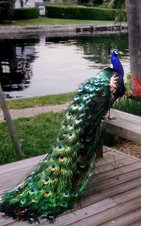 |
| One of the peachicks; it was never easy to tell them apart. |
Ms. Bird's peachicks gained size fast, which we assumed gave them protection from predators. Despite their size, they remained chicks in behavior. While Ms. Bird was constantly on alert, scanning her surroundings, the chicks would become preoccupied with whatever they were doing.
This would then result in sudden panic when any threat appeared, or even if their mother had moved to be temporarily out of sight. The chicks would startle, behaving "like chickens with their heads cut off."
This seems to have caused the death of one of the chicks the late afternoon of Jan. 2, 2015.
I was in the house when I heard persistent and obviously alarmed crowing from Ms. Bird. I got up to investigate, but turned back and grabbed my camera, thinking I might get a shot of this occasional behavior.
 |
The last photo I have of the three birds together.
Peachicks are easily as big as Ms. Bird! |
On the front sidewalk I encountered a neighbor, John, walking his own large dog on a leash. As we met, a large brown dog I didn't recognize walked out of the side yard of my house toward John.
"Do you know this beast?" I asked John, ironically, wondering why it would be on the loose. He said he knew the dog from the neighborhood, and called it by name, indicating he would take charge of it.
"THAT bird," he said, nodding to my side yard, "flew all the way up and hit the high tension power line. I think he may have been shocked."
I looked down the side yard and spotted one of the peachicks lying on its side, on the ground. Ms. Bird was above it, on the roof line of the neighboring house, continuing to crow loudly.
At this moment I must have taken a photo of the scene, although I don't remember doing so. I was shocked later to find a blurry photo on the camera. Ms. Bird, being all white, may be invisible in the washed out area above the roof, or perhaps had moved just out of sight. She never stopped crowing loudly.
 |
| The photo I don't remember taking. Crumpled bird barely visible. |
What I do remember doing is approaching the injured bird and taking it into my arms — it made only one off-center scrape along the ground trying to escape me and then did not resist. It looked at me. It was still alive but I felt no heartbeat.
I asked John to summon Bonnie. He again described the bird flying into the power line that runs along the sidewalk, right by the power pole, and then plummeting straight down. My guess is that the bird was startled by the big dog and flew into the spider web of power lines that meet at the pole.
Perhaps it was shocked, or perhaps the impact with wires and fall proved fatal (I would subsequently find a large feather and lots of blue/white peachick fluff directly under the pole). John told me the fallen bird had gotten up the length of the side yard on its own speed, fleeing the big dog.
The dog may have been just curious and may never have touched the bird for all I know.
The peachick died before we could get it to the Wildlife Care Center. We left the body with them.
A neighbor pointed out that it might have been better to bury the bird at home, with Ms. Bird watching. It might have prevented what we saw the next day: Ms. Bird and the remaining chick seemingly frantically searching.
The deceased chick had been the larger of the two and had been showing signs of being dominant, even pecking at Ms. Bird and its sibling to establish who would eat first.
"Oh, that was her favorite," another neighbor said when told of the death. How much we read into these birds our own emotions! I was just glad that I got to hold the chick at the end and grateful that humans have arms that can enfold other creatures. Perhaps it matters to them. It certainly did to me.










